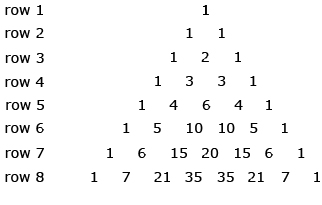In Lesson 3 you looked at combinations. Do you think there could be a connection between combinations and Pascal’s triangle? In Try This 3 you will explore whether there is a relationship between combinations and Pascal’s triangle.
Try This 3
- Consider the following table of combinations and their values.
TABLE OF COMBINATIONS
Combination
Value
0C0
1
1C0
1
1C1
1
2C0
1
2C1
2
2C2
1
3C0
1
3C1
3
3C2
3
3C3
1
4C0
1
4C1
4
4C2
6
4C3
4
4C4
1
- Describe a relationship between the table of combinations and Pascal’s triangle.

- Try your relationship for row 7.
- Use your relationship to predict the 1st, 2nd, 3rd, and 4th numbers of row 34 of Pascal’s triangle.
- Determine the first four terms of (x + y)33.

- Describe a relationship between the table of combinations and Pascal’s triangle.
- Explain a general method that can be used to predict the terms of the expansion of (x + y)n.
![]() Save your responses in your course folder.
Save your responses in your course folder.
Share 3
With a partner or group, discuss the following question based on the information in Try This 3.
Compare the strategies you thought of to determine the terms of the expansion of (x + y)n.
![]() If required, save a record of your discussion in your course folder.
If required, save a record of your discussion in your course folder.